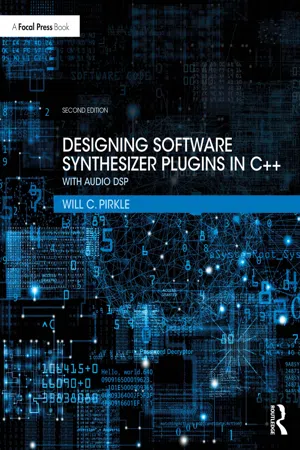
- 276 pages
- English
- ePUB (mobile friendly)
- Available on iOS & Android
About this book
Designing Software Synthesizer Plugins in C++ provides everything you need to know to start designing and writing your own synthesizer plugins, including theory and practical examples for all of the major synthesizer building blocks, from LFOs and EGs to PCM samples and morphing wavetables, along with complete synthesizer example projects.
The book and accompanying SynthLab projects include scores of C++ objects and functions that implement the synthesizer building blocks as well as six synthesizer projects, ranging from virtual analog and physical modelling to wavetable morphing and wave-sequencing that demonstrate their use. You can start using the book immediately with the SynthLab-DM product, which allows you to compile and load mini-modules that resemble modular synth components without needing to maintain the complete synth project code. The C++ objects all run in a stand-alone mode, so you can incorporate them into your current projects or whip up a quick experiment. All six synth projects are fully documented, from the tiny SynthClock to the SynthEngine objects, allowing you to get the most from the book while working at a level that you feel comfortable with.
This book is intended for music technology and engineering students, along with DIY audio programmers and anyone wanting to understand how synthesizers may be implemented in C++.
Frequently asked questions
- Essential is ideal for learners and professionals who enjoy exploring a wide range of subjects. Access the Essential Library with 800,000+ trusted titles and best-sellers across business, personal growth, and the humanities. Includes unlimited reading time and Standard Read Aloud voice.
- Complete: Perfect for advanced learners and researchers needing full, unrestricted access. Unlock 1.4M+ books across hundreds of subjects, including academic and specialized titles. The Complete Plan also includes advanced features like Premium Read Aloud and Research Assistant.
Please note we cannot support devices running on iOS 13 and Android 7 or earlier. Learn more about using the app.
Information
1 SynthLab Introduction
1.1 What You Need to Know to Use SynthLab Objects and Projects
1.2 SynthLab Synth Projects
- SynthLab-WT: four-oscillator wavetable synth that includes ordinary wavetable, morphing wavetable, and one-shot drum and sound effect (SFX) wavetable implementations; the various oscillators may be used in any combination
- SynthLab-PCM: PCM sample playback synth with four separate PCM oscillators; this synth uses.wav files for its PCM sample storage and retrieval
- SynthLab-VA: four-oscillator virtual analog synth using virtual analog oscillators and filters
- SynthLab-KS: physical modeling synth that uses the Karplus-Strong plucked string algorithm to generate realistic acoustic and electric guitar and bass sounds
- SynthLab-DX: four-operator FM synth that produces the classic Yamaha DX synth sounds
- SynthLab-WS: wave sequencing synth based on the Korg Wavestate’s ® multi-lane, independent looping wave sequencer that allows use of both normal and morphing wavetable oscillators during the sequencing operation; the wave sequencing oscillator demonstrates how to create an amalgam of modules encapsulated in a single object
1.2.1 SynthLab Documentation
1.3 Synth Components
Component | Abbreviation | Description |
|---|---|---|
Synth engine | Engine | The entire synth, in one object that manages a set of voices |
Synth voice | Voice | This term is not always used the same way, but for SynthLab, it is the object that renders each note-event; a voice contains a collection of one or more of the components below (LFO, EG, etc.) |
Low frequency oscillator | LFO | An oscillator with frequency fo on the range of about 0.02 to 20.0 Hz, though numerous variations on these limits are allowable |
Envelope generator | EG | Produces a unipolar control signal used to modulate other components; it is most closely associated with the output amplifier, where it sets the time-domain contour of the rendered signal |
Digitally controlled amp | DCA | A variable gain and panning amplifier used on the output of each voice |
Virtual analog filter | VAFilter | A synth filter des... |
Table of contents
- Cover
- Half Title
- Title Page
- Copyright Page
- Dedication
- Table of Contents
- List of Figures
- List of Tables
- Preface
- 1 SynthLab Introduction
- 2 The Synth Engine
- 3 Synth Voices, Synth Modules, and Module Cores
- 4 Synth Operational Modes: Polyphony and Voice-Stealing
- 5 Learning and Using the SynthLab Objects & Projects
- 6 Modulation: Theory and Calculations
- 7 Envelope Generators and DCA
- 8 Low Frequency Oscillators
- 9 Wavetable Oscillators
- 10 Virtual Analog Oscillators
- 11 PCM Sample Playback Oscillators
- 12 Synthesizer Filters
- 13 Karplus-Strong Plucked String Model
- 14 The Modulation Matrix
- 15 Wave Morphing and Wave Sequencing
- 16 The SynthLab Synth Projects
- Index